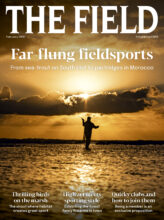Made in association with Rizzini, the EJ Churchill Hercules is a true all-rounder, as comfortable on a game drive as it is at the local clay ground, says Michael Yardley
EJ Churchill Hercules gun review
This month we look at two EJ Churchill Hercules guns. The guns, a 12-bore and a 20-bore, are over-and-unders made in association with Battista Rizzini in northern Italy but benefit from EJ Churchill’s gunmaking, game-shooting and instructional experience.
EJ CHURCHILL HERCULES REVIEW

Both guns are sideplated and profusely engraved with acanthus scrollwork in Churchill’s attractive house style (applied by laser but finished by an artisan). The 12-bore EJ Churchill Hercules, as primarily tested, has a coin-finished action, whereas the 20-bore Hercules Colour has a chemically applied case-hardened effect to the action. The latter version of the gun costs significantly more but also has enhanced wood (both guns have a traditional English oil finish).
The guns featured have 30in barrels, which would be my call in this type of gun in 12- or 20-bore, although as a bespoke product there are other choices from 28in to 32in. They weighed in at 7lb 10oz and 7lb 2oz, respectively, with open-radius full-pistol-grip stocks. The grips themselves are well-proportioned and steel-capped. The stocks present with elegant tapered combs and sensible shelf dimensions. They are, however, usually ordered to the customer’s measurements. There are all sorts of no-cost stock options available on the Hercules, including straight hand (which may be had with double triggers), palm swell and half pistol grip, and a Monte Carlo comb.
This model, launched in March 2020 (five days into the Covid crisis), is also available in 16-bore, 28-bore and .410, all with fixed or multi-chokes. I have to express a prejudice in favour of the 30in 20-bore. It is a combination that rarely fails to please, although the 12-bore has arguably more versatility and the 28-bore will bring a smile to most faces, as will the .410 if you have the skill to use it.
The test guns both had automatic top strap conventional thumbpiece sliding safeties (a non-selective safety is another no-cost option). They are fleur-de-lys proofed for steel shot and each has an excellent solid, tapered (8mm to 6mm) sighting rib, solid joining rib and rounded game fore-end without schnabel, so those who want to extend a front hand may do so without the hindrance of a lip.
The Hercules is intended as an all-rounder. It would be ideal in a traditional line or hide, on a simulated day or simply in a casual session breaking pitch discs with friends at the local shooting ground. EJ Churchill has now sold well over 100 of this model and says: “It is our best-selling gun and for a good reason. This gun was designed for the modern game shooter who demands a sharp-shooting game gun that is as happy in the field as it is on the clay ground.”

Unlike others, these guns will shoot game or clays equally well. The weights and shapes are right and conform to my own ideals. There is enough mass to steady the guns and absorb recoil but not so much as to make them ungainly or ponderous in use. They feel comfortable and the aesthetics are good.
I have a particular fondness for sideplate guns of this type. The plates provide extra space for decoration but also put a little more weight between the hands, so they handle more like sidelocks while benefiting from the reliability of a CNCmade trigger-plate action. This design has evolved considerably over the past 40 years due to British market preferences and English gunmaking input pushing it on. It is a much better-looking and better-made gun than it once was. It’s particularly good in 20-bore with a solid rib. The action aesthetics and handling have progressed but the basic mechanical design always was sound and reliable.
TECHNICAL
The EJ Churchill Hercules is precision-built on a proven trigger-plate design used by several Brescian makers and further refined with English input. It combines elements of Beretta and Browning. Trunnion hinging by means of stud pins at the knuckle contributes to the lowering action profile, reducing muzzle climb/flip and improving action aesthetics into the bargain. Rearwards the gun is locked by means of a Browning-style flat bolt engaging a slot bite beneath the bottom mouth. Some makers prefer the Boss/Perazzi system at the rear to reduce action height where a bolt comes down upon elliptical projections that locate in recesses in the lower action face. Beretta does it with its clever conical bolts either side of the top chamber mount. Rizzini has continued with the simple Browning-style bolt but paid significant attention to refining action shapes, notably by rounding the bottom of the action bar. The design is simple, elegant and reliable.
SHOOTING IMPRESSIONS
I shot the 12-bore Hercules at EJ Churchill’s Buckinghamshire ground. It was the sort of gun that makes testing a pleasure from a shooting point of view but tough journalistically. The Hercules didn’t miss a beat; the evolved specification is spot on. The stock shapes were also excellent. In use, the 12-bore did not recoil excessively, the trigger-pulls were fine and the gun looked good – it would not disgrace itself in any company. Pleasing, too, is the engraving and there is no excessive bling. I did not shoot the 20-bore as pictured but I have shot a nearly identical gun with great results. The combination of a 20-bore action with 30in barrels and solid rib works especially well. I would struggle to criticise these guns. The Colour version is a little more expensive but looks superb. The Hercules is on the money.
KEY INFORMATION FOR EJ CHURCHILL HERCULES
♦ RRP: 12-bore Hercules, £11,500; 20-bore Hercules Colour, £14,000
♦ EJ Churchill, Park Lane, Lane End, Stokenchurch, High Wycombe HP14 3NS
♦ 01494 883227




